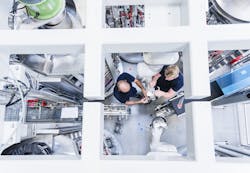How to Build a Better Robotic Work Cell
Robots have the potential to significantly increase productivity, quality, and safety across a range of industrial applications. That’s the theory, anyway. The performance of the finished system is driven by the details of the design. Here, we review best practices in robotic work cell design with an emphasis on common pitfalls and techniques for success.
Tip #1: Define the Application
Before any design work takes place or any parts are specified, it is essential to have a clear definition of the task the robot is going to perform. Will it be inspecting parts? Loading blanks into a magazine? Populating PCB boards? Determine the tasks and the level of performance required to execute them successfully.
The best way to start this process is to say to yourself, “I’m going to make a change to my manufacturing and at the end of this change, the following things will be true…” and list those items.
You will want to return to this step throughout the design cycle to ensure that the items on the list are still applicable. If you are not keeping to the objectives, do you need to change the design, or do you need to change the objectives as your design evolves?
Tip #2: Run Simulations to Optimize
Once you have detailed the tasks, you can establish a preliminary design and specify parts. Next, use simulation to explore operation and troubleshoot problems. Simulations make it possible to determine work envelopes and cycle times to try out different layouts and techniques.
As an example, customers often start out specifying SCARA robots because they have a reputation for speed. SCARA robots, while very fast, are optimized for horizontal motion rather than vertical motion. If the process involved is based around vertical motion, an articulated arm might be a better solution.
Articulated arms are expensive and limited, though. Sometimes, the solution is to both modify the type of robot and also change the support automation around the robot. A pick and place application might improve through modifications of the infeed/outfeed of the conveyor supplying parts. Through simulation, you can explore all of these options without committing to hardware.
Simulation can isolate kinematic singularities—points at which the robot is no longer able to move the end effector to the desired location, no matter what the location of the joints. Singularities typically manifest when three or more joints (generally axis 4, axis 5, and axis 6) are positioned on top of one another. Once they are detected during simulation, the kinematics can be altered to eliminate the issue.
Simulation also makes it possible to examine torque loadings on each axis, which can have implications for the lifetime of the robot. If one axis is moving 80% of the time and the other axes of the arm are moving perhaps 15% or 20% of the time, the primary axis is likely to fail sooner. Simulation makes it possible to modify objects in the work envelope to more evenly distribute work among the axes of the robot arm.
Tip #3: Don’t limit yourself by past manual process or standards. Let the robot be a robot, not a human.
Simply mapping over a manual process to a robot will typically not be successful. Consider the differences between the two. Human beings have two arms while robots typically have one. Human beings have legs and can move around whereas most robots are fixed in place. Robots typically have longer reach than human beings and can move faster and with better accuracy. A robot may not be able to reach around another object, however. You may need to change the positioning of one machine to another. When adapting a manual process to a robotic work cell, take these factors into account.
A common pitfall is to attempt to design a robotic work cell such that a human being can step in and do the work if the robot fails. Unfortunately, the differences between robots and human beings are such that this sort of hybrid design serves neither approach well. It tends to drive prices up, increase space claim, and compromise performance. Commit to a robotic solution and design appropriately to that solution. If the design is effective and robust, you will not need to swap in a human operator.
Tip #4: Make sure you build in practical flexibility.
This is not a single task where you're trying to do something with a single discipline. It's not just a mechanical design, it's not just an electrical design or software design. It’s a mixture. Software is fantastic but without the sensor technology to give it input, it can be useless. I can have the best sensors and the best software programming but if I don't properly design my end of arm tooling then you know I am in trouble.
You have to keep on going back to results that you want to obtain because by doing so you can empower a great deal of capability into your machine if you choose to.
Tip #5: Get input from people who do the work now. They know things you don’t.
There are the little bits of info that you get from talking to the operators because they've put a million of these things together. That's why their input is critically important in automating a process.
For more information, click here

